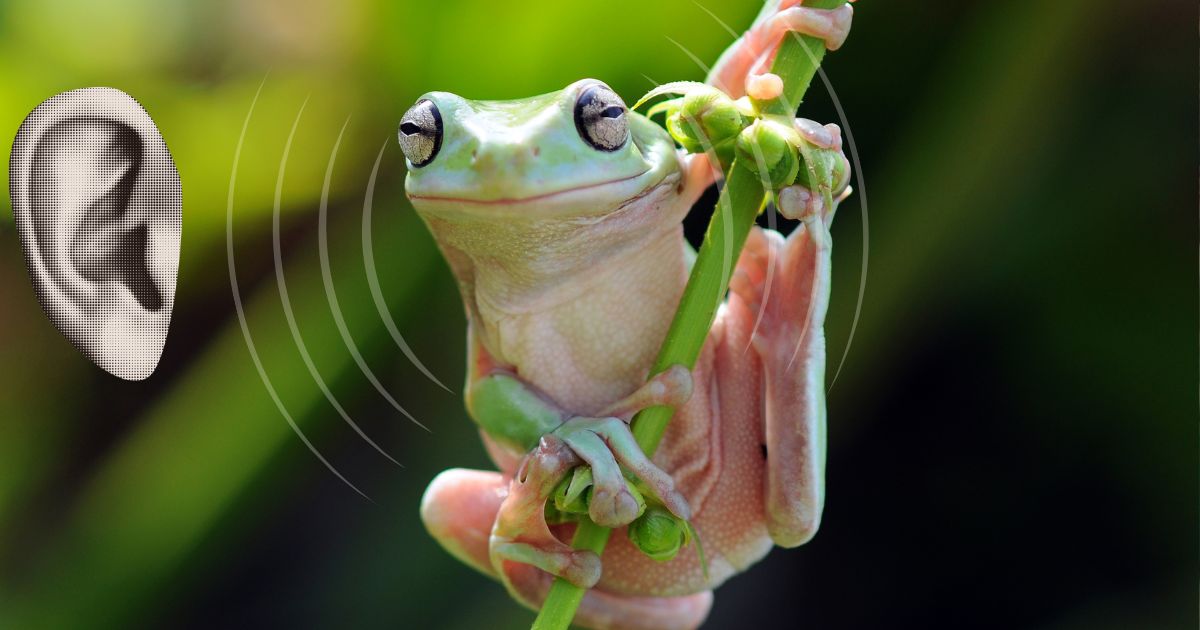On social media today, I’m seeing important articles that will benefit people with hearing loss (if they read the articles). My friend Shari Eberts writes about what a person should look for in a hearing health care professional. Other people are encouraging people to advocate for clear masks so that we can understand what the heck people are saying.
Then there’s me, writing about being able to hear frogs.
Can you? Hear frogs ribbiting, I mean?
I can! But I couldn’t hear them for years, probably decades, and being able to hear them now has great significance for me.
Getting Back Sounds with a Cochlear Implant
My cochlear implant (CI), which I received in Toronto three and a half years ago, has given me back an incredible chunk of the world’s sounds. But the smooth process of adapting to hearing with my bionic cochlea was interrupted a few months after implantation by the onset of serious somatosensory tinnitus and hyperacusis. This new type of head noise was bothersome enough (to put it mildly) to interfere with audibility, and everything was just so darn loud.
Five months after implantation, I moved to Vancouver where I started working with a wonderful CI audiologist who also specializes in tinnitus. When I started working with her, I had been wearing my CI sound processor all day, from the time I got up until I went to bed. Apparently not everyone does this, especially in the early months. Every day, I spent a couple of hours listening through only my CI and not with the hearing aid in the other ear.
I was following the CI mantra that, to successfully train the brain to interpret the sounds through my CI, one must Practice, Practice, Practice! As a result, my early hearing tests with the CI showed a rapid improvement in what I could hear and understand. After a lifetime of annual hearing tests that showed a decline in hearing, these positive results with the CI were nothing less than thrilling.
Then all of a sudden, it wasn’t so thrilling. The tinnitus/hyperacusis combination was at times almost debilitating, and my audiologist suggested a break in CI practice while I worked on dealing with the anxiety caused by this head noise. For some reason, that break stretched longer and longer, and I only occasionally did some CI-only listening.
But a few months ago I had a sobering revelation – my CI test scores weren’t as good as they used to be. “Why did I get this hole in my head if I’m not going to make the most of it!” I thought to myself. “Get back at it, girl!”
And so I did. I’m practicing regularly because my next cochlear hearing test is in November, and I want to leave that clinic with a smile!
I find that when I spend even an hour or two listening through my CI, my bimodal hearing improves. Words sound brighter, fuller, better. I practice by watching TV, reading a book on my computer with the text-to-speech mode, talking to my husband and while out hiking. As a result of targeted daily practice, my own voice sounds less hollow through the CI than it used to and voices sound more natural. I hear the sibilant s’s and sh’s, which make speech sound as rich to the ear as butterscotch fudge tastes to the tongue.
Learning to Hear with a Cochlear Implant
Learning to hear through a cochlear implant is not a time-limited offer; the brain will respond to retraining at any time, an exciting thing to learn. If you’re interested in the neuroplasticity of the brain – and who isn’t? – I recommend a wonderful book called The Brain That Changes Itself by Norman Doidge. It’s fascinating and, trust me, if someone like me, whose brain usually goes numb at science stuff, can understand and enjoy it, anyone can.
So, back to frogs. Lately, I’ve been hearing frogs like I haven’t heard since – ever! This is, I believe, a direct result of my recent training. Also, because they are loud! They are Pacific tree frogs, also known as the Pacific chorus frog. Apparently the call of an amorous male sounds similar to “ooh-yeeh”. I find this phonetic description funny although I don’t actually hear it like that. To me, the frog is belting out some plain old frog ribbits.
In my frog research I also discovered that the frog is a Spirit Animal and when a frog makes repeated appearances in your life (as it has in mine), it means that the Spirit wants you to learn and grow from change. It’s about transition and transformation. How amazing – that is exactly what a cochlear implant has done for me.
*Important note to those considering a cochlear implant: my case of incurring somatosensory tinnitus is highly unusual, and we believe it was not caused by the cochlear implant. Please don’t let my story negatively influence your exploration into getting a cochlear implant. With hand on my heart, I can tell you that even with this rarer type of tinnitus, I still hear incredibly much better than I did prior to receiving my CI.
About the Author
 Gael Hannan is a writer, speaker and advocate on hearing loss issues. In addition to her weekly blog The Better Hearing Consumer, which has an international following, Gael wrote the acclaimed book “The Way I Hear It: A Life with Hearing Loss“. She is regularly invited to present her uniquely humorous and insightful work to appreciative audiences around the world. Gael has received many awards for her work, which includes advocacy for a more inclusive society for people with hearing loss. She lives with her husband on Vancouver Island, British Columbia, Canada.
Gael Hannan is a writer, speaker and advocate on hearing loss issues. In addition to her weekly blog The Better Hearing Consumer, which has an international following, Gael wrote the acclaimed book “The Way I Hear It: A Life with Hearing Loss“. She is regularly invited to present her uniquely humorous and insightful work to appreciative audiences around the world. Gael has received many awards for her work, which includes advocacy for a more inclusive society for people with hearing loss. She lives with her husband on Vancouver Island, British Columbia, Canada.








This reminds me about hearing frogs when I was about a year in in my first CI, I’m bilateral. I put a load of laundry in and my laundry room backs up to my back door. It was 10:00 pm and I kept hearing these horribly loud noises outside. I knew it couldn’t be birds and it was driving me crazy as to what the sounds were. Finally I asked my husband, “what is that noise”? When he told me frogs, at first I didn’t believe him. I took a flashlight out and found to my astonishment that he was right. That was 15 years ago. I still hear sounds that I’m not always able to identify but I always try. It delights me when I find out though. I’m guessing that normal hearing people don’t really understand how much they hear and take for granted. Not me, and I know most of my CI friends don’t either.
I have a friend who adopted a Deaf teenager, and exposed her to many new-for-her experiences, including the time we went canoeing on a gentle river. We’re having a great time, chatting in sign language about all the beauty and wildlife we were seeing. The Mom and I remarked about a huge noisy bull frog sitting on a log. The girl could see the frog’s throat pouch moving, but never knew they made a croaking noise. It was an education for all of us about what we as hearing people took for granted, and the girl learned that a lot of visuals are associated with sound.